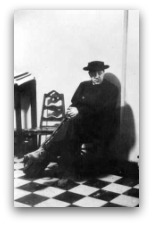main: August 2009 Archives
Ronan Guilfoyle is an Irish jazz musician and educator whose blog, Mostly Music, probes issues that concern working musicians as well as academics in institutions  where jazz is taught. Those are often the same people. Increasingly, professional jazz players also teach in jazz schools. In part, that is because they need day gigs to support themselves; it should be unnecessary to convince anyone that for all but a handful of stars, there is little steady employment playing jazz. In part, it is because they are dedicated to an educational ideal, helping young musicians develop.
where jazz is taught. Those are often the same people. Increasingly, professional jazz players also teach in jazz schools. In part, that is because they need day gigs to support themselves; it should be unnecessary to convince anyone that for all but a handful of stars, there is little steady employment playing jazz. In part, it is because they are dedicated to an educational ideal, helping young musicians develop.
In a recent post titled "In Defence of Jazz Education", Guilfoyle begins his essay by attributing to "the jazz media" three common criticisms of jazz education. However much one might like to duck it, his scattershot indictment of jazz writers bears enough justification to be taken seriously. Guilfoyle characterizes his triumverate of ignorant assertions as "knee jerk attacks."
1) Jazz education turns all who partake of it into clones.
2) The proof of jazz education's failure is the fact that though there are more practitioners than ever before the percentage of great players hasn't got any higher.
3) What is the point of turning out jazz graduates when there are no gigs?
In discussing the clone argument, Guilfoyle writes:
What a lot of critics forget about is that most high level jazz school courses are staffed and run by professional jazz musicians. These are musicians who deal with the realities of playing the music, and who are aware of the skills necessary to survive in the professional milieu. And it is largely these same musicians who decide the curricula for the schools - not some faceless bureaucrat. So the information that is provided is largely that body of information which professional musicians agree are basic prerequisites for a life as a professional jazz musician. This basic information - harmonic, technical and rhythmic as well as repertoire - is generally agreed by most professionals to be part of the essential toolkit of the contemporary jazz musician.
Yet the writer James Lincoln Collier says:'With students all over the United States being taught more or less the same harmonic principles, it is hardly surprising that their solos tend to sound much the same. It is
important for us to understand that many of the most influential players developed their own personal harmonic schemes, very frequently because they had little training in theory and were forced to find it their own way.'
So - there we have it, the noble savage syndrome - for the sake of your creativity and originality it's better to have no training. It's hard to know where to start with the refutation of an argument this stupid. It's like suggesting that if you want to become a writer it would be better to to be illiterate and figure out the rules of English yourself, rather than go to school and be taught how to read, how spelling, grammar and syntax work, and being directed towards great writing of the past. Yet this is the bizarre subtext of much of the criticism of jazz education - in order to be creative and original it's better to be uneducated. But though these writers idealise the self-taught musicians of the
past, how many of these same jazz greats would have taken advantage of educational institutions had they been available to them? Most I'd say. And if they had, would it have stifled their creativity? Would Coltrane have sounded like a thousand other saxophonists if he'd gone to a jazz school? To suggest that he would have is to deny his innate genius and originality.
To read all of "In Defence of Jazz Education" and more of Ronan Guilfoyle's stimulating views, click here.
You've got to learn your instrument. Then, you practice, practice, practice. And then, when you finally get up there on the bandstand, forget all that and just wail. - Charlie Parker
He had just what we needed. He had the line and he had the rhythm. The way he got from one note to the other and the way he played the rhythm fit what we were trying to do perfectly. We heard him and knew the music had to go his way.... He was the other half of my heartbeat. - Dizzy Gillespie
Charlie Parker was born in Kansas City on this date in 1920. The Rifftides staff debated whether to observe the occasion by publishing a 5000-word essay tracing Parker's musical heritage, analyzing the components of his style and evaluating his influence on several generations of musicians. You'll be happy to know that we decided instead to take Bird's advice in the film below and let his music speak for itself.
This is the only known clip of Parker actually playing. In several others he is seen performing to pre-recorded sound tracks. The man presenting 1951 Down Beat awards to Parker and Dizzy Gillespie is the columnist Earl Wilson, assisted by critic Leonard Feather. The rhythm section is Dick Hyman, piano; Sandy Block, bass; and Charlie Smith, drums. The piece is Tadd Dameron's "Hot House." The staff is aware that many of you have seen this clip. We are equally aware that you can't see it too often.
Jack Brownlow has been dead nearly two years, but stories about him keep surfacing. Among his other attributes, the pianist was admired for his harmonic ingenuity, chord placement, taste and timing in accompanying instrumentalists and vocalists. At Brownlow's memorial service in the fall of 2007, drummer Phil Snyder told several stories about his musical adventures with the man known to his friends as Bruno. He forgot to tell one, though, and sent it to share with Rifftides readers.
As you know, Bruno could play anything in any key. He knew the lyrics to almost every standard song. If they asked him, he also coached singers and advised them how to be better. That combination helped make him a singer's dream pianoplayer. But he hated to do it if they weren't good.
One summer day in the '70's, he was in bassist Jim Anderson's living room accompanying a singer who had stopped by to perform for Jack and consult with him about improving himself. When I walked in, Jack and the singer were in the middle of "On a Clear Day," so I quietly sank into the beanbag chair in the corner facing the piano. The man singing was someone I had never heard or seen, a handsome guy with dark skin and curly hair nicely coifed. He had a Latin accent. He sang as if he were every woman's desire, though there weren't any women in the room, just Bruno and me. The singer used a lot of arm and hand gestures. He was facing the piano and couldn't see me, but Bruno and I had eye contact.This guy's singing was terrible. Bruno was embarrassed and wouldn't look at me. He turned his head to the left and faced the wall away from the singer. Bruno played no choruses. Finally, "On A Clear Day" was over. Bruno fiddled with the music on top of the piano. After uncomfortable silence, the singer asked him, "What do you think?" Bruno said nothing. "Let's try something else," the singer said." "How about 'Have You Met Miss Jones?"'
Reluctantly, Bruno played an introduction and the singing began. It was a terrible rendition, with mispronunciations and scrambled phrasing. Finally, that was over, too. "Let's do one more," the singer pleaded. "Let's do a ballad." Bruno looked at me and rolled his eyes. With excitement, the singer said, "'My Funny Valentine?' Do you know that one Mr. Brownlow?" Bruno nodded. The singer launched into it and gave rubato a whole new meaning. Finally, "Valentine" was over. Bruno sighed and stood up.
"Well, Mr. Brownlow...what do you think?"
Bruno didn't say anything. He briefly looked at me, and started to shuffle the music on the piano again.
"Mr. Brownlow? What do you think about my singing? "Do you think I have a great voice?"
Bruno had a difficult time telling an untruth about anything musical. At the same time, he didn't want to hurt anybody's feelings. Finally, he looked at the man and said, "Great voice? No, I wouldn't say you had a great voice. It needs some work."
"How about my pitch?"Still shuffling papers, Bruno stood up, then sat down again.
"Your pitch?"
"Yes! My pitch. You know...am I singing in tune?"
Again an uncomfortable pause. "In tune? No, not exactly. You could
work on that, actually."The singer was getting disturbed.
"How about my, how do you musicians put it, my swinging? Am I swinging? I think I was swinging."
I was sitting behind the piano trying to keep quiet and not break up. Bruno was starting
to sweat, which I'd never seen him do before.
"Swinging?" he said.
"Yes, yes, yes. You must understand swinging. Was I swinging?"
Silence. Bruno looked again at me. Quietly, every quietly, Bruno said, "A little bit." He paused. Actually, I wouldn't say that. Not swinging...not exactly swinging. No. I'd have to say no on that."
The singer was upset. Bruno was clutching a bunch of music in
his arms as if to protect himself from blows. I was lying back on the
beanbag chair, but not comfortably. The room was very tense.
Finally, the singer, who at this point was pacing back and forth,
mumbled forcefully."Now wait a minute. Let me get this straight. You said I don't have a good voice. Isn't that right?"
Bruno looked away. "Well, that might be overstat... "
"And then you said that my pitch was wrong, that I was out of tune. Right?"
"Well, I didn't put it quite that way, but yes..."
"Then Mr. Brownlow, you said that I am not swinging at all. Isn't that also what you said?"
Bruno, now terrified about what this guy was going to do next, tried to ease his pain. "Well, well, a little bit of swinging, I suppose...toward the end there..."
"STOP!" said the singer.
Again there was uncomfortable, really uncomfortable, silence in the room. Bruno didn't move. I didn't move. The singer quit pacing, looked at Bruno and said,
"I come here to sing for you and for you to judge my singing. You tell me that my voice is bad, my pitch is bad, and my rhythm is bad. What else is there?"
Again, there was a pause. Bruno was trying to find something positive to say. Finally, he blurted,
"Your posture is EXCELLENT!"
If I had known of Ethan Iverson's conversation with Lee Konitz about Lester Young, I would have included a link to it in the previous exhibit. On his blog, Do The Math, Iverson, the pianist and polymath of The Bad Plus, posts what amounts to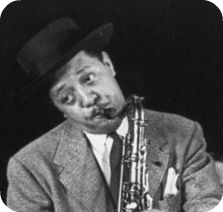 a Prez master class with Konitz. The alto saxophonist has been intimately familiar for more than sixty years with Young's early work, so familiar--it turns out--that as he and Iverson listened to the recordings, he could sing along with most of Prez's classic solos from the Count Basie years.
a Prez master class with Konitz. The alto saxophonist has been intimately familiar for more than sixty years with Young's early work, so familiar--it turns out--that as he and Iverson listened to the recordings, he could sing along with most of Prez's classic solos from the Count Basie years.
Here is part of their discussion after they had listened to Lester's solo on "Twelfth Street Rag."
Lee sang this longish, fastish solo impeccably. He looked quite sad at the end.
LK: How can you talk about these jewels? Each one seems better than the next. Ethan, why are you exploring Lester Young now?
EI: I'm trying to fill in some holes in my playing. But also, the more I listen to Lester Young, the more I hear how amazing he is.
LK: Same thing here. I love him more all the time.
EI: This tune is corny, in a way, but they make it so hip.
LK: When you can play like this, the material becomes almost less important - it's just a springboard for pure improvisation and pure music.
Iverson includes in his blog piece transcriptions of Young solos and MP3 players that allow the reader to hear them. Unfortunately, the only way I could hear and see them at the same time was to open two copies of the blog and position them side by side on the screen. It is worth the effort. Even if you are not a skilled sight reader, it is fascinating to follow along on the manuscript as Prez unrolls his creations. To go to Do The Math and Iverson's comprehensive 10-part Lester Young symposium with Lee Konitz, click here.
Here is a final thought about Lester Young--for today, at least. It comes from the late tenor saxophonist Bill Perkins and has to do with Prez's subtle trailblazing harmonic 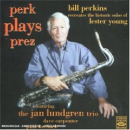 approach. It suggests a lineage that may surprise conventional thinkers. When I spoke with him in 1996 as I prepared notes for his superb CD Perk Plays Prez, Perkins said:
approach. It suggests a lineage that may surprise conventional thinkers. When I spoke with him in 1996 as I prepared notes for his superb CD Perk Plays Prez, Perkins said:
Harmonically, Prez was getting outside, in his way. In "Taxi War Dance," for instance, he gets into a whole different mode, scale-wise. He was the first man I knew to use, rather than third scales and triads, fourths and fifths and big jumps. I can't think of another player who did that. Everybody does it now, but he was unique with that. Bix Beiderbecke used some very interesting jumps in his melodies--big jumps--and his sound was beautiful. I think that might have had an influence. Prez loved Bix.
Lester Young was born 100 years ago today and died in his 49th year in March, 1959. Billie Holiday called him the president of the tenor saxophonists. His nickname became Prez, and he called nearly everyone else Prez. There is an endless list of musicians who played as they did mostly because of Young. It includes soloists as various as Parker, Artie Shaw, Paul Quinichette, Paul Desmond, Wardell Gray, Dexter Gordon and 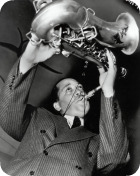 Brew Moore, to name a few of hundreds. Moore carried his discipleship so far as to declare, "Anyone who doesn't play like Lester Young is wrong."
Brew Moore, to name a few of hundreds. Moore carried his discipleship so far as to declare, "Anyone who doesn't play like Lester Young is wrong."
Among Lester's stylistic children are virtually all of the Brothers who came through the Woody Herman band, starting with the tenor players of the first Four Brothers section--Zoot Sims, Stan Getz and Herbie Steward--and continuing with Al Cohn, Bill Perkins, Gene Ammons, Richie Kamuca, Dick Hafer, and on and on and on. No one could count the grandchildren and great-grandchildren because Young's inheritors are players of all instruments, whether or not they are aware of their gifts from him. His way of playing is part of the lingua franca of jazz.
Here are a few observations in a book I wrote called Jazz Matters:
In the early 1930s, Lester Young was removed from the Fletcher Henderson band for not playing like Coleman Hawkins. But from his first recordings with Count Basie in 1936, Young's lightness, buoyancy, rhythmic daring and harmonic subtlety established him as a hero of forward-looking musicians. He provided an evolutionary step between Louis Armstrong and Charlie Parker in the freeing of the jazz soloist from the arbitrary restrictions of time divisions. In his solos, Young flew weightlessly over bar lines. He saw deeply into chord changes. He helped lay the rhythmic and harmonic keystones of bebop.
Young was drafted in 1944, even though he was in bad health and admitted he had used marijuana for the past decade. The Army confiscated his horn, refused to let him play in the camp band, and later arrested him on drug charges. He was dishonorably discharged, but first he was imprisoned for ten months at an Army base in Georgia, an experience with devastating emotional consequences. In spite of his experience in the military, his attempts to recover from its dehumanizing effects, and his efforts to build his own withdrawn world of sweetness and love, Young was capable of playing tenor sax with inventiveness, relaxation and swing never achieved by any other jazz soloist.
Although Louis Armstrong may have been the first soloist to erase bar lines and smooth out jazz improvisation with long, logical, flowing passages, Prez is the man who brought total relaxation to the process and yet managed at the same time to extend the boundaries of rhythmic propulsion. No one had ever done more swinging while creating beautiful ideas.
YouTube does not allow us to embed their video of Lester as featured soloist with the Basie Band at the Randall's Island jazz festival in 1938. He is in the silent film but the sound track dubbed in is one of his great solos with Basie on "I Got Rhythm" chord changes. Click here to see and hear him.
Toward the end of his life, Young's oblique approach to melodies and his ultra-relaxed rhythm could create the impression that he was having trouble finding his way. To the contrary, his habit of lagging behind the beat was the product of assurance and of comfort with his surroundings. There are wonderful instances of that in this new compilation of latterday Lester. But there is no more memorable example than in his 1957 reunion with Billie Holiday, whose deep friendship and musical empathy with Young went back to the 1930s. Creating just twelve uncomplicated bars of music, Prez finds the essence of beauty and the blues. This is the famous "Fine and Mellow" from the 1957 CBS-TVprogram The Sound of Jazz. Ben Webster has the first tenor saxophone solo, Lester the second.
Billie Holiday (with Doc Cheatham obligato)
Ben Webster
Lester Young
Holiday (with Cheatham)
Vic Dickenson (trombone)
Gerry Mulligan (baritone saxophone)
Holiday
Coleman Hawkins (tenor saxophone)
Roy Eldridge (trumpet)
Holiday
Best moment of the day, ten minutes ago:
Coming to the end of a long bicycle ride, I passed a church playground not far from the house. A boy of about three ran out of the mass of children on swings and jungle gyms and yelled, "Hey."
"Hey," I replied.
"Can you go home?" he said.
"I'm going home," I told him.
"Can you get your girl friend and come back and play?"
She was tempted, but she had just put a pie in the oven.
In the e-mail today came yet another news release using one of the favorite clichés of record company publicists. It announced the release of "the sophomore album" of a young saxophonist. A sophomore is a second-year student at a high school, college or university. You could look it up. The word is not a synonym for "second." The saxophonist's fourth release, I presume, will be his senior album, the fifth his post-graduate album, the sixth his post-doctoral album.
Strunk and White's The Elements of Style is still available. Their 12th principle of composition is, "Use definite, specific, concrete language." Please.
This concludes today's rant.
The world may have known about it, but I just stumbled upon a rich cache of Elis Regina video clips on YouTube. They come from a 1973 Brazilian television special. The program seems to have been available on a DVD that quickly disappeared from the market. Amazon, CD Universe, Netflix and several other sources say it is currently unavailable and, according to Amazon, "we don't know when or if this item will be back in stock." That is a pity, because in the clips Regina, at age 28, is brilliant in every song, giving clear evidence why she was beloved in Brazil and idolized by singers and musicians throughout the world.
market. Amazon, CD Universe, Netflix and several other sources say it is currently unavailable and, according to Amazon, "we don't know when or if this item will be back in stock." That is a pity, because in the clips Regina, at age 28, is brilliant in every song, giving clear evidence why she was beloved in Brazil and idolized by singers and musicians throughout the world.
The video of "Ladeira da Preguiça," a happy song, is a good introduction to the series of 20 clips. They run the range of emotions and expressivity that Regina commanded to an extent equaled by few musicians in any idiom. The trio is headed by pianist Cesar Camargo Mariano, her second husband and the father of her daughter Maria Rita, now also a star in Brazil. The bassist and drummer are not identified. Elis Regina died in 1982 at the age of 36.
This is a link to the complete Elis Regina YouTube collection from the TV special. Be prepared to fall in love.
Browsing the works of my fellow artsjournal.com bloggers this morning, I discovered in his blog Overflow a piece by Harvey Sachs that illuminates the condition of American popular culture in the new century. Mr. Sachs, the distinguished biographer of Arturo Toscanini and Artur Rubinstein, recently repatriated to the US after decades overseas. He posted this item nearly two months ago, but it has a long shelf life. Here is an excerpt:
I had heard of Michael Jackson, knew that he was an entertainer -- knew, even, that he was odd looking and that he had a sister who had bared a breast,accidentally or otherwise, before the television cameras during some sort of sporting event. (None of my friends in Europe, where I was living at the time, could understand why this had created a scandal. "Was her breast ugly?" was the closest any of them, male or female, could come to fathoming the issue.) What I did not know, however, was that at some point during my long absence from the country this Jackson fellow had replaced Jesus Christ as the primary object of worship for most Americans.
Fortunately, I was traveling in the Midwest from Friday until Tuesday morning, thus I had the incredible privilege of taking in an enormous quantity of television "news" in hotel lobbies and breakfast rooms, in restaurants, and in a few private homes. My imagination was fired by the rare chance to see how the early prophets of a new religion manipulate the masses. And on Saturday, when I realized what was about to happen, I began to tremble all over.
To read the whole thing, click here.
Welcome back to the United States, Mr. Sachs.
No one ever accused Stan Getz of phoning in a solo. Not infrequently, however, he gave the appearance of detachment as he played while surveying the audience with eyes wide open. When he closed those cool blue eyes and leaned into a solo, something special was likely to happen. In Italy in 1961, cameras caught an instance of Getz fully committed. Video of the event surfaced not long ago. The tune is Dizzy Gillespie's "Woody 'n You." Ray Brown is on bass, Ed Thigpen on drums. The pianist is Lou Levy, Getz's friend since their days in Woody Herman's Second Herd and always one of his favorite playing partners. The audio track has a couple of dropouts, but your ear will fill them in.
You don't rehearse jazz to death to get the camera angles. - Stan Getz
A good quartet is like a good conversation among friends interacting to each other's ideas. - Stan GetzThe saxophone is an imperfect instrument, especially the tenor and soprano, as far as intonation goes. The challenge is to sing on an imperfect instrument that is outside of your body. - Stan Getz
Let's face it--we'd all sound like that if we could. - John Coltrane
Over at JazzWax, Marc Myers is conducting a multi-part interview with Laurie Verchomin, the "Laurie" of Bill Evans's famous composition. During the final year-and-a-half of his life, when he was in physical deterioration and creative resurgence, Evans and Verchomin had a romantic and intellectual relationship of depth and intensity. His years of drug addiction had doomed him, and he knew it. She dedicated herself to him in his final months. This is one of the exchanges in the second installment of the interview.
JW: Why was someone as gifted and as in control as Evans so hopelessly addicted to something so obviously destructive?
LV: I never did figure that out. That part of him was a really deep place. I don't know why someone like Bill would be so persistently self-destructive. It's such a conundrum. It's such a riddle. For me it's still a mystery. The only way to understand Bill was to realize that destruction and creativity exist simultaneously. Because Bill was so intensely creative, he had an intensely destructive side. He told me he never could do anything halfway. It all had to be to the extreme. He felt the same way about his addictions.
To read transcripts of the first and second installments of the Laurie Verchomin interview, go to JazzWax.
Months ago, Bill Kirchner sent a note about examples he was using in one of his New School classes for emerging composers. I set it aside, meaning to enlarge upon it. I just came across the tickler file reminding me. Clearly, my tickler system needs work. Here is Kirchner's message. Where possible, I've added links.
Yesterday, I brought some scores/recordings to my New School comp/arr class for the students to check out. Among them were Bob Brookmeyer's "The Nasty Dance" (an undersung masterpiece for Mel Lewis's 1982 big band featuring Joe Lovano)*, two recent big-band pieces by Mike Gibbs ("Rumour Has It" and "Gather the Meaning"), and Holman's classic "What's New?" for Stan Kenton.
Holman once remarked that he wrote the "What's New?" chart after hearing the 3rd and 4th Bartók String Quartets. If you play a recording of the opening to the 3rd Quartet and then the Kenton recording, you'll hear the similarity.
*(Unforgivably out of print -- DR)
In his play-by-play notes to the Mosaic box set, Stan Kenton: The Complete Capitol Recordings of the Holman and Russo Charts (out of print), Will Friedwald quotes Holman on the gestation of his arrangements of "What's New?" and "I've Got You Under My Skin," another piece Kenton wanted for his Contemporary Concepts album.
Holman: The idea for these two tunes was to write long charts, based on standard tunes, but to make them like an original piece. Just use thechanges or a (melodic) fragment to tie it together; in other words, make them like an original - although you don't get royalties for it! But they were double the length of the usual chart. You could stretch out and do what you want. I remember the day we were all in New York, as part of the '54 All Star Concert Tour with the Kenton guys plus Shorty Rogers and his Quintet. They were going to continue on but I was going to stay there. I remember Shorty, Jack Montrose and I were walking down 48th Street where all the music stores were. We started looking through some scores and I found Bartok's Third and Fourth Quartets.
I remember after the band left and I finally got down to writing these charts I was looking through the Bartok things and I got an idea for "What's New." Sometimes looking at something like that can give you an idea - not necessarily something that's specifically in there - but just puts something you can use into your head. Just an approach. Stan said to make 'em long and not worry bout keeping the melody going all the time. The standard changes are there so you can follow them if you're used to listening to jazz that way.
"What's New" is the lead track on Contemporary Concepts, generally considered the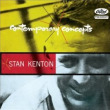 best album of Kenton's career. Recorded in 1955, it also includes "I've Got You Under My Skin," "Stella By Starlight," "Cherokee," "Stompin' at the Savoy" and "Yesterdays," all arranged by Holman, and Gerry Mulligan's arrangement of his own "Limelight."
best album of Kenton's career. Recorded in 1955, it also includes "I've Got You Under My Skin," "Stella By Starlight," "Cherokee," "Stompin' at the Savoy" and "Yesterdays," all arranged by Holman, and Gerry Mulligan's arrangement of his own "Limelight."
Bill Kirchner is no newcomer to admiration for the older arranger. Years ago, preparing a piece about Holman, I asked several arrangers about him. Kirchner said,
Bill Holman is "Mr. Line." His linear concepts are among the most important innovations ever used in a jazz orchestra. His chart on "What's New" on the Contemporary Concepts album for Kenton is a masterpiece."
And so it is, a perennial example for arrangers and a joy for listeners. The producers of the CD reissue added four tracks from Kenton's "Opus" genre, respectable journeyman works whose unintended effect is to emphasize the brilliance of the original Contemporary Concepts charts.
Bill Evans was born 80 years ago today. He enriched music.
By way of his splendid JazzWax blog, Marc Myers alerts the Rifftides staff that our little slice of bandwidth gets a bit of notice. In my naiveté, I didn't know there was such a thing as a blog rating service, but Marc points to Invesp Consulting. If you go there, you will see several segments in which Rifftides is rated at or near the top. We follow only Wynton Marsalis and Contemporary Jazz in "The Ultimate Rank," place first in "Top Jazz Blogs By The Number Of Incoming Links," place first in "Top Jazz Blogs By Google PR" (!), and rank high in several other categories, as does JazzWax. Every line in the Invesp list is a link to a blog, making it easy to use the page as a point of departure for exploring.
list is a link to a blog, making it easy to use the page as a point of departure for exploring.
Thanks to all Rifftides readers for being aboard as we navigate the tides, shoals and high seas of our fifth year.
Rashied Ali, a drummer who applied his advanced technique to free jazz, died today in New York. He was 76. Born Robert Patterson, Ali became a disciple and close colleague 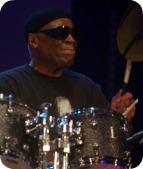 of his fellow Philadelphian John Coltrane. He played on some of the most uninhibited recordings of Coltrane's final years, including the astonishing Interstellar Space, a series of free duets. I was on a selection committee for Grammy nominations in 1974, the year Impulse! Records released Interstellar Space. Pianist Billy Taylor, one of the other members of the committee, said during the listening session, "I can't imagine two people making more music than that." It was a tour de force for both musicians. In this video clip from an Eastern European television program, Ali discusses Coltrane's impact on his life and music.
of his fellow Philadelphian John Coltrane. He played on some of the most uninhibited recordings of Coltrane's final years, including the astonishing Interstellar Space, a series of free duets. I was on a selection committee for Grammy nominations in 1974, the year Impulse! Records released Interstellar Space. Pianist Billy Taylor, one of the other members of the committee, said during the listening session, "I can't imagine two people making more music than that." It was a tour de force for both musicians. In this video clip from an Eastern European television program, Ali discusses Coltrane's impact on his life and music.
Here is Ali with his quintet in June of 2008. The other players are tenor saxophonist Lawrence Clarik, trumpeter Josh Evans, pianist Greg Murphy and bassist Joris Teepe.
Rashied Ali, RIP.
Les Paul, who affected the course of popular music in profound ways, died today at the age of 94. Jazz devotees may remember the guitarist most fondly from the days in the 1930s when he collaborated with Louis Armstrong, Roy Eldridge and Art Tatum, or his involvement with Jazz At The Philharmonic and a memorable 1944 blues duet with Nat Cole. He went on to star on radio and television, invent equipment, come up with innovative recording techniques and zoom to the top of the pop charts with hit records. I thought about importing video clips to illustrate Paul's career, but I could not improve on the nine-minute obituary the producers of PSB's The News Hour with Jim Lehrer put together on this evening's newscast. With the gratitude of the Rifftides staff, here it is:
involvement with Jazz At The Philharmonic and a memorable 1944 blues duet with Nat Cole. He went on to star on radio and television, invent equipment, come up with innovative recording techniques and zoom to the top of the pop charts with hit records. I thought about importing video clips to illustrate Paul's career, but I could not improve on the nine-minute obituary the producers of PSB's The News Hour with Jim Lehrer put together on this evening's newscast. With the gratitude of the Rifftides staff, here it is:
John Stowell, Solitary Tales (Origin). The CD's title suits the guitarist, a peripatetic performer who roams the world. I recently heard a musician say, "You never know where he'll show up." Although Stowell often plays with others, some of his most stunning work, as here, is unaccompanied. He alternates acoustic and electric guitars, but when he is plugged in he keeps his amplifier volume low and his attack subtle. The listener is more likely to be involved with the gentle insistence of Stowell's long lines and development of harmonic possibilities than concern with which instrument he's playing.
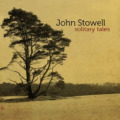 He opens with Cole Porter's "Everything I Love," mining it for chords to alter, phrases to stretch or contract and, following a contemplative solo, a coda that swings the track to a close. He plays pieces by Bill Evans, Steve Swallow and Ornette Coleman and six of his own compositions. "Funny Man," an Evans tune rarely played by others, gets a series of single-note-line runs that Stowell builds on Evans's intriguing chord structure. Swallow's impressionistic "Willow" is another highlight. Stowell's treatment of Coleman's "Blues Connotation," has deep inflections in the bass notes, time that pulses beneath the surface, and wry commentary hinting at call-and-response. Of his own pieces, "Fun With Fruit" and "Laughing River" are as intriguing as their mysterious titles. This could be party music, I suppose, if you were having a very quiet party. For full enjoyment, it requires--and rewards--close attention
He opens with Cole Porter's "Everything I Love," mining it for chords to alter, phrases to stretch or contract and, following a contemplative solo, a coda that swings the track to a close. He plays pieces by Bill Evans, Steve Swallow and Ornette Coleman and six of his own compositions. "Funny Man," an Evans tune rarely played by others, gets a series of single-note-line runs that Stowell builds on Evans's intriguing chord structure. Swallow's impressionistic "Willow" is another highlight. Stowell's treatment of Coleman's "Blues Connotation," has deep inflections in the bass notes, time that pulses beneath the surface, and wry commentary hinting at call-and-response. Of his own pieces, "Fun With Fruit" and "Laughing River" are as intriguing as their mysterious titles. This could be party music, I suppose, if you were having a very quiet party. For full enjoyment, it requires--and rewards--close attention
In this video clip, Stowell plays a medley of two Wayne Shorter pieces,"Fall" and Nefertiti," not included in Solitary Tales.
When Stowell is at his home base in the US Pacific Northwest, he frequently performs with two of that region's world-class musicians, bassist Jeff Johnson and drummer John Bishop. In this video, tenor saxophonist Rick Mandyck joins them in a piece with the misleading title, "Turgid," which is on their Scenes CD.
When The National Endowment for the Arts study on Public Participation in the Arts came out a few weeks ago, the survey's bad news about the size of the jazz audience caused ripples of concern. It showed that over a six-year period, the number of Americans attending jazz events dropped to a low of 7.8%. In a population of 301 million, that translates to attendance of 2,347,800 each year at jazz clubs, concerts and festivals. As if that weren't discouraging enough to those worried about the state of jazz, the audience for live jazz is growing older. According to the study, in 1982 the median age of listeners at live performances was 29. In 2008, it was 46.
Over the weekend, Terry Teachout's Wall Street Journal column about the NEA study amplified those ripples of concern into waves as his piece was picked up by web sites and blogs. What are the implications of the numbers above and of the study's other statistics of decline? Teachout, also an artsjournal.com blogger, wrote:
I suspect it means, among other things, that the average American now sees jazz as a form of high art. Nor should this come as a surprise to anyone, since most of the jazz musicians that I know feel pretty much the same way. They regard themselves as artists, not entertainers, masters of a musical language that is comparable in seriousness to classical music--and just as off-putting to pop-loving listeners who have no more use for Wynton Marsalis than they do for Felix Mendelssohn.
Terry ended his column with this:
No, I don't know how to get young people to start listening to jazz again. But I do know this: Any symphony orchestra that thinks it can appeal to under-30 listeners by suggesting that they should like Schubert and Stravinsky has already lost the battle. If you're marketing Schubert and Stravinsky to those listeners, you have no choice but to start from scratch and make the case for the beauty of their music to otherwise intelligent people who simply don't take it for granted. By the same token, jazz musicians who want to keep their own equally beautiful music alive and well have got to start thinking hard about how to pitch it to young listeners--not next month, not next week, but right now.
Fellow artsjournal.com blogger Howard Mandel, responding to Teachout, charges him with "forecasting the death of jazz." In his column, Teachout does not do that. But, having set up the straw man, Mandel knocks it down with a series of illustrations that jazz is flourishing, all encouraging. You can read them in his new posting at Jazz Beyond Jazz.
"How to pitch it" is Teachout's key phrase in his conclusion. Let's take that to mean improvements in presentation, audience education and marketing. If jazz musicians find ways to reach larger audiences without watering down their art, it will be good for them and the future of the music. Calculated attempts to increase audience by forcing hybridization of the music itself have neither elevated its quality nor achieved permanent increases in attendance figures and record sales for uncompromised music. Such amalgams as disco jazz, soft jazz, smooth jazz and other varieties of near-jazz have done wonders for Kenny G and John Tesh, but little for players of undiluted jazz.
In a barroom discussion of such compromises, the guitarist Jim Hall once said, "Where do I go to sell out?" That was decades ago. You'll notice that he hasn't sold out. It may be that the NEA study illuminates what serious artists have always known even as they dreamt of popular acceptance, fame and wealth. The pianist John Lewis articulated it, and his quote has been popping up in the wake of the study: "The reward for playing jazz is playing jazz."
In the introduction to Jazz Matters: Reflections on the Music and Some of its Makers, I reflected on the matter of the jazz audience. Here's an excerpt:
For a few years in the 1940s and 1940s, when the big band phenomenon resulted in a congruence of jazz and popular music, jazz records sometimes became best sellers. That happened not because the music was jazz, but because it was popular despite its being jazz. The high artistic quality of a hit like Erskine Hawkins's "Tuxedo Junction" or Charlie Barnet's "Cherokee" was coincidental. In succeeding decades when an anomaly like Stan Getz's "Desifinado" or Dave Brubeck's "Take Five" made the top forty, there was a revival of the old hope, born during a few unreproduceable years of the swing era, that jazz could again be a part of mass culture.
It is understandably painful to jazz musicians to witness the enormous popularity of inferior music based on jazz, and to see many of its practitioners become wealthy. A talented musician working for union scale might feel despair to read in one day's newspaper that Bruce Springsteen, the rock star, earned an estimated $56 million in 1986-87, and in the next day's edition find Springsteen quoted, "Chuck (Berry) played in a lot of strange keys, like B-flat and E-flat," these "strange keys" actually being two of the least complicated. Like so much in life, commercial dominance by the slightly talented and musically ignorant is not fair. It may be time, however, as the brilliant alto saxophonist Phil Woods has suggested, for jazz players and listeners to accept the fact their music is art music, that commerce is commerce, and that the more sophisticated and artistically complete jazz becomes, the less likely it is to be a wide commercial success.Because of its enormous strength, vitality and creative energy, jazz has from its beginnings influenced trendy popular offshoots. Fusion, crossover and the so-called New Age or earth music of the 1980s are only the latest manifestations of a tradition that goes back at least as far as the soupy sweet bands and chirpy pop songs of the l920s. Indeed, the popular music of the past sixty years in virtually all of it forms, especially including rock, would not have existed had there been no jazz. This could fairly be called a mixed blessing.
Still, despite the occasional brief popular acclaim of a jazz artist, the mother lode of American music remains untapped by most Americans.
Like Terry Teachout, I don't know how to interest young people in jazz. I tend to think, based on observation and anecdotal information, that rather more of them listen to jazz than the NEA study suggests. Study results often lag behind current realities. I hope that's the case here. I am sure of one thing; the de-emphasis and, in many cases, elimination, of arts education in public schools has done enormous damage to audience-building for music, literature, theatre and the visual arts. There are many more contributing factors, including the spread of instant communication with the result that young people are conditioned to instant gratification rather than slow, deep appreciation. That is a worldwide cultural and societal problem. I don't know how to solve it, either.
Go here to read a summary of the NEA study.
Hiromi (she goes by her first name) started picking out a pretty stride version of "I Got Rhythm,'' but it erupted into a lightning storm that would have stunned Bud Powell. She half-stood and bounced on her feet as she played, her hands a blur. She leaned into the piano and bobbed her head, heavy-metal-drummer-style.To read all of Greenlee's account of Hiromi's performance and of the festival, go here.
 As the Alps tower over Swiss villages, stacks of compact
As the Alps tower over Swiss villages, stacks of compact discs tower over me. Sampling, auditioning, listening at length when something grabs my ear, I make my way through the CD Alps that surround me. If I live to be 115, which is my plan, there is no possibility of my fully hearing more than a smattering of these discs. Some of the arrivals in the never-ending stream of albums are from veterans, young and old, recording for prominent companies. Many more are by musicians or singers who produce, distribute and market their own wares. They hope that in the new economic reality of the record business their CD calling cards will land gigs, sales, reviews or notice from established labels. First in this brief survey of recent listening is one that could do all of that.
discs tower over me. Sampling, auditioning, listening at length when something grabs my ear, I make my way through the CD Alps that surround me. If I live to be 115, which is my plan, there is no possibility of my fully hearing more than a smattering of these discs. Some of the arrivals in the never-ending stream of albums are from veterans, young and old, recording for prominent companies. Many more are by musicians or singers who produce, distribute and market their own wares. They hope that in the new economic reality of the record business their CD calling cards will land gigs, sales, reviews or notice from established labels. First in this brief survey of recent listening is one that could do all of that.
 Lena Seikaly, Written In The Stars (Lena Seikaly). Ms. Seikaly sings with a rich mezzo-soprano voice, using intonation, timbre and control that reflect her classical training. Her phrasing, feeling and improvisatory leanings come from an understanding of jazz values. She makes the unconventional, even daring, decision to open her debut album by scatting her way into "East of the Sun and West of the Moon." Musicianship and her sense of proportion make the track, and the CD, a success. Ms. Seikaly may scat too much for some tastes, but she does it with a musician's grasp of harmony, not merely straining to be hip.
Lena Seikaly, Written In The Stars (Lena Seikaly). Ms. Seikaly sings with a rich mezzo-soprano voice, using intonation, timbre and control that reflect her classical training. Her phrasing, feeling and improvisatory leanings come from an understanding of jazz values. She makes the unconventional, even daring, decision to open her debut album by scatting her way into "East of the Sun and West of the Moon." Musicianship and her sense of proportion make the track, and the CD, a success. Ms. Seikaly may scat too much for some tastes, but she does it with a musician's grasp of harmony, not merely straining to be hip.
The more intriguing aspects of her performances here are in the ways she uses phrasing and tonal shadings to interpret songs when she's singing lyrics. There is an effective instance of that element of her work as she imparts a minor, almost modal, cast to her final chorus on "When I Fall in Love." She brings slight but effective variations of the melody to her straightforward treatments of "The Very Thought of You" and "Duke Ellington's Sound of Love," one of Charles Mingus's most moving ballads. Ms. Seikaly and tenor saxophonist Bobby Muncy achieve a rich blend on the wordless "Gravitation" and on "Written in the Stars," two of her four compositions here. Muncy solos well in a style influenced by John Coltrane. The Washington, DC, rhythm section is comprised of pianist Nathan Lincoln-Decusatis, bassist Tom Baldwin and drummer David McDonald. Leonardo Lucini subs on bass for one track. Ms. Seikaly is a singer with significant potential.
Bobby Broom, Plays For Monk (Origin). Broom is too young to have worked with Thelonious Monk. He has been Sonny Rollins's guitarist for nearly thirty years. Rollins was a Monk sideman who absorbed the pianist's compositional, harmonic and rhythmic ethos, and it is likely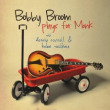 that some of Rollins's Monk wisdom has rubbed off on Broom. When he was very young, Broom also worked with Art Blakey, Monk's ideal drummer. However he obtained it, in this relaxed, accessible collection, he brings depth of understanding to interpretations of eight Monk compositions and two standards that Monk enjoyed playing. Broom is not a speed demon virtuoso of the guitar, but a thoughtful improviser who knows the uses of space in the lines he creates. With bassist Dennis Carroll and drummer Kobie Watkins, Broom finds the beauty, humor, subtlety and swing that Monk put into "Ruby, My Dear," "Evidence," "Work," "Bemsha Swing" and, emphatically, the joy Monk always transmitted in his performances of the old pop song "Lulu's Back in Town." Broom gives a heartfelt treatment of Monk's ballad "Reflections," a composition of structural perfection. The guitarist graces the piece in a moving solo that Carroll follows with a statement of equal
that some of Rollins's Monk wisdom has rubbed off on Broom. When he was very young, Broom also worked with Art Blakey, Monk's ideal drummer. However he obtained it, in this relaxed, accessible collection, he brings depth of understanding to interpretations of eight Monk compositions and two standards that Monk enjoyed playing. Broom is not a speed demon virtuoso of the guitar, but a thoughtful improviser who knows the uses of space in the lines he creates. With bassist Dennis Carroll and drummer Kobie Watkins, Broom finds the beauty, humor, subtlety and swing that Monk put into "Ruby, My Dear," "Evidence," "Work," "Bemsha Swing" and, emphatically, the joy Monk always transmitted in his performances of the old pop song "Lulu's Back in Town." Broom gives a heartfelt treatment of Monk's ballad "Reflections," a composition of structural perfection. The guitarist graces the piece in a moving solo that Carroll follows with a statement of equal 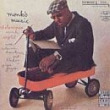 beauty. Broom closes with a Monk favorite, Jerome Kern's "Smoke Gets in Your Eyes." He plays it unaccompanied, out of tempo and with what may well be reverence for Kern as well as for Monk.
beauty. Broom closes with a Monk favorite, Jerome Kern's "Smoke Gets in Your Eyes." He plays it unaccompanied, out of tempo and with what may well be reverence for Kern as well as for Monk.
If you don't get the reference implied in the CD's cover photo, this picture will help. It's one of Monk's classic Riverside albums, Monk's Music. Among its other virtues, it has Coleman Hawkins and John Coltrane as sidemen.
Frank Glover, Politico (Owl). Glover plays clarinet in modern mainstream territory that shares a border with free jazz. In this reissue of a 2005 CD that had limited distribution, he performs with the energized rhythm section of pianist Steve Allee, bassist Jack Helsley and drummer Bryson Kern. His writing for a string ensemble on one piece and a 14-piece band on another has intimations of Gil Evans and Béla Bartok. Glover's playing, rich and woody in the lower register, tends toward shrillness during virtuoso excursions into the upper regions of the horn. His improvisations have a nice balance between long phrases and whirlwind flurries with adventuresome interval leaps. In the final movement of his 3-part "Concierto Para Quarteto," Glover and pianist Allee execute stunning unison passages that blend in and out of free sections so subtly that only the closest attention discloses what is written and what is improvised. Stimulating stuff.
free jazz. In this reissue of a 2005 CD that had limited distribution, he performs with the energized rhythm section of pianist Steve Allee, bassist Jack Helsley and drummer Bryson Kern. His writing for a string ensemble on one piece and a 14-piece band on another has intimations of Gil Evans and Béla Bartok. Glover's playing, rich and woody in the lower register, tends toward shrillness during virtuoso excursions into the upper regions of the horn. His improvisations have a nice balance between long phrases and whirlwind flurries with adventuresome interval leaps. In the final movement of his 3-part "Concierto Para Quarteto," Glover and pianist Allee execute stunning unison passages that blend in and out of free sections so subtly that only the closest attention discloses what is written and what is improvised. Stimulating stuff.
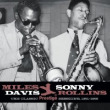 Miles Davis, Sonny Rollins, The Classic Prestige Sessions, 1951-1956 (Prestige). The 25 tracks in this two-CD set have been reissued to a faretheewell over the years in various configurations, and no doubt will continue to be for years to come. Like Louis Armstrong's Hot Fives and Hot Sevens, Dickens novels, the poetry of Yeats and Fred Astaire's films, they should be available in perpetuity. The five years of recordings here cover some of Davis's and Rollins's best work from their relative conceptual innocence in the immediate post-bop period to the mid-fifties, when each had become a formidable musician on the verge of fame and enormous influence. The sidemen constitute a hall of fame of the era. They include John Lewis, Percy Heath, Roy Haynes, Walter Bishop Jr., Art Blakey, Jackie McLean, Horace Silver and Charlie Parker. Yes, Charlie Parker. For any serious jazz listener, familiarity with these recordings is necessary to an understanding of how jazz developed over the past sixty years. A valuable bonus is Ira Gitler's liner note memoir about the days when he worked at Prestige as a jack of all trades and was intimately involved with most of the musicians who produced this essential music
Miles Davis, Sonny Rollins, The Classic Prestige Sessions, 1951-1956 (Prestige). The 25 tracks in this two-CD set have been reissued to a faretheewell over the years in various configurations, and no doubt will continue to be for years to come. Like Louis Armstrong's Hot Fives and Hot Sevens, Dickens novels, the poetry of Yeats and Fred Astaire's films, they should be available in perpetuity. The five years of recordings here cover some of Davis's and Rollins's best work from their relative conceptual innocence in the immediate post-bop period to the mid-fifties, when each had become a formidable musician on the verge of fame and enormous influence. The sidemen constitute a hall of fame of the era. They include John Lewis, Percy Heath, Roy Haynes, Walter Bishop Jr., Art Blakey, Jackie McLean, Horace Silver and Charlie Parker. Yes, Charlie Parker. For any serious jazz listener, familiarity with these recordings is necessary to an understanding of how jazz developed over the past sixty years. A valuable bonus is Ira Gitler's liner note memoir about the days when he worked at Prestige as a jack of all trades and was intimately involved with most of the musicians who produced this essential music
Marc Myers' JazzWax wraps up a four-part interview with Denny Zeitlin, packed with good questions, and answers that give insights into an intriguing man. For decades, Zeitlin has maintained parallel careers as a jazz pianist and a practicing psychiatrist. Myers asked him how empathy plays a role in both pursuits.
When I'm doing my most effective work as a musician playing with other musicians, I try to lose that positional sense of self so I can enter their musical worldand merge with what they're doing. With a patient in my office, I do my most effective work when I'm able to enter their psychological life so deeply that I can really seem to feel what it is that he or she is feeling. Yet in both cases, there's a part of me that is still available, that is able to pull back and observe the process that both of us are in.
To read all of the interview, go to JazzWax.com. For a piece I wrote about Zeitlin in The Wall Street Journal earlier this year, go here.
Yesterday was Louis Armstrong's 108th birthday, and I forgot to mention it. To make up for that oversight, Rifftides brings you Armstrong in 1958. Pops's singing and playing partner is his pal of 30 years, Jack Teagarden. Louis was 57 years old and playing beautifully on every level -- range, tone and ideas. At 2:41, listen to him turn a little lip bobble into pure gold. The cornetist who kicks things off is Ruby Braff.
One day I heard a pianist play `Honeysuckle Rose,' ... and I was hooked. I said, `What is that?' He said, `jazz,' which was a word I had never heard, and I asked him to spell it for me. My life was changed after that. - Joe Zawinul
I am an improviser, ... I improvise music. Whatever you want to call it all, it is all improvised music. I may capture it and go back and write it down for others, but it was originally improvised. - Joe Zawinul
For a white Viennese boy to write a tune that's that black is pretty remarkable. He just captured the essence of the African-American heritage, just the statement of melody and feeling of that song. Clearly, in some past life, Joe must've been black. - Herbie Hancock on "Mercy, Mercy, Mercy."
Zawinul has been gone nearly two years. For a Rifftides reminiscence posted upon his passing, go here. It includes the story of why Cannonball Adderley's first-choice take of "Mercy, Mercy, Mercy" was nixed by the record company.
Put aside all of the old arguments about whether this is jazz, jazz-rock, fusion, world music, ethnic music, R&B, funk or something else. The arguments don't matter anymore, if they ever did. This is truly, to borrow Ellington's overused phrase, beyond category. There is no more stunning instance of what rhythm, harmony and harmonics can do for a repeated riff. Joe Zawinul wrote the song. This version of Weather Report is Zawinul at his electronic keyboard arsenal, Wayne Shorter playing two kinds of saxophone, Jaco Pastorius on bass and Peter Erskine on drums. The performance is from a concert in Germany in 1978. There are a couple of rough spots in the tape. Be glad the tape exists. YouTube says this clip has been viewed more than a million times.
Have a good weekend.
AJ Ads
AJ Blogs
AJBlogCentral | rssculture
Terry Teachout on the arts in New York City
Andrew Taylor on the business of arts & culture
rock culture approximately
Laura Collins-Hughes on arts, culture and coverage
Richard Kessler on arts education
Douglas McLennan's blog
Dalouge Smith advocates for the Arts
Art from the American Outback
Chloe Veltman on how culture will save the world
For immediate release: the arts are marketable
No genre is the new genre
David Jays on theatre and dance
Paul Levy measures the Angles
Judith H. Dobrzynski on Culture
John Rockwell on the arts
innovations and impediments in not-for-profit arts
Jan Herman - arts, media & culture with 'tude
dance
Apollinaire Scherr talks about dance
Tobi Tobias on dance et al...
jazz
Howard Mandel's freelance Urban Improvisation
Focus on New Orleans. Jazz and Other Sounds
Doug Ramsey on Jazz and other matters...
media
Jeff Weinstein's Cultural Mixology
Martha Bayles on Film...
classical music
Fresh ideas on building arts communities
Greg Sandow performs a book-in-progress
Harvey Sachs on music, and various digressions
Bruce Brubaker on all things Piano
Kyle Gann on music after the fact
Greg Sandow on the future of Classical Music
Norman Lebrecht on Shifting Sound Worlds
Joe Horowitz on music
publishing
Jerome Weeks on Books
Scott McLemee on books, ideas & trash-culture ephemera
theatre
Wendy Rosenfield: covering drama, onstage and off
visual
Public Art, Public Space
Regina Hackett takes her Art To Go
John Perreault's art diary
Lee Rosenbaum's Cultural Commentary
